BIZ202: Evaluating Macroeconomic & Social Factors on Business
VerifiedAdded on 2023/06/10
|10
|2136
|188
Report
AI Summary
This report summarizes solutions related to environmental scanning, emphasizing the use of PESTLE analysis for assessing external conditions, particularly for Coles supermarket. It highlights the importance of technological advancements, social media marketing, and exploring opportunities in various sectors. The report further delves into macroeconomic factors like declining consumer purchasing power and social factors such as increasing health consciousness, discussing their implications for businesses. It also addresses challenges stemming from technological advancements, economic pressures, and corporate social responsibility, providing a comprehensive overview of the business environment and its complexities. Desklib offers a range of study tools, including past papers and solved assignments, to aid students in their academic pursuits.
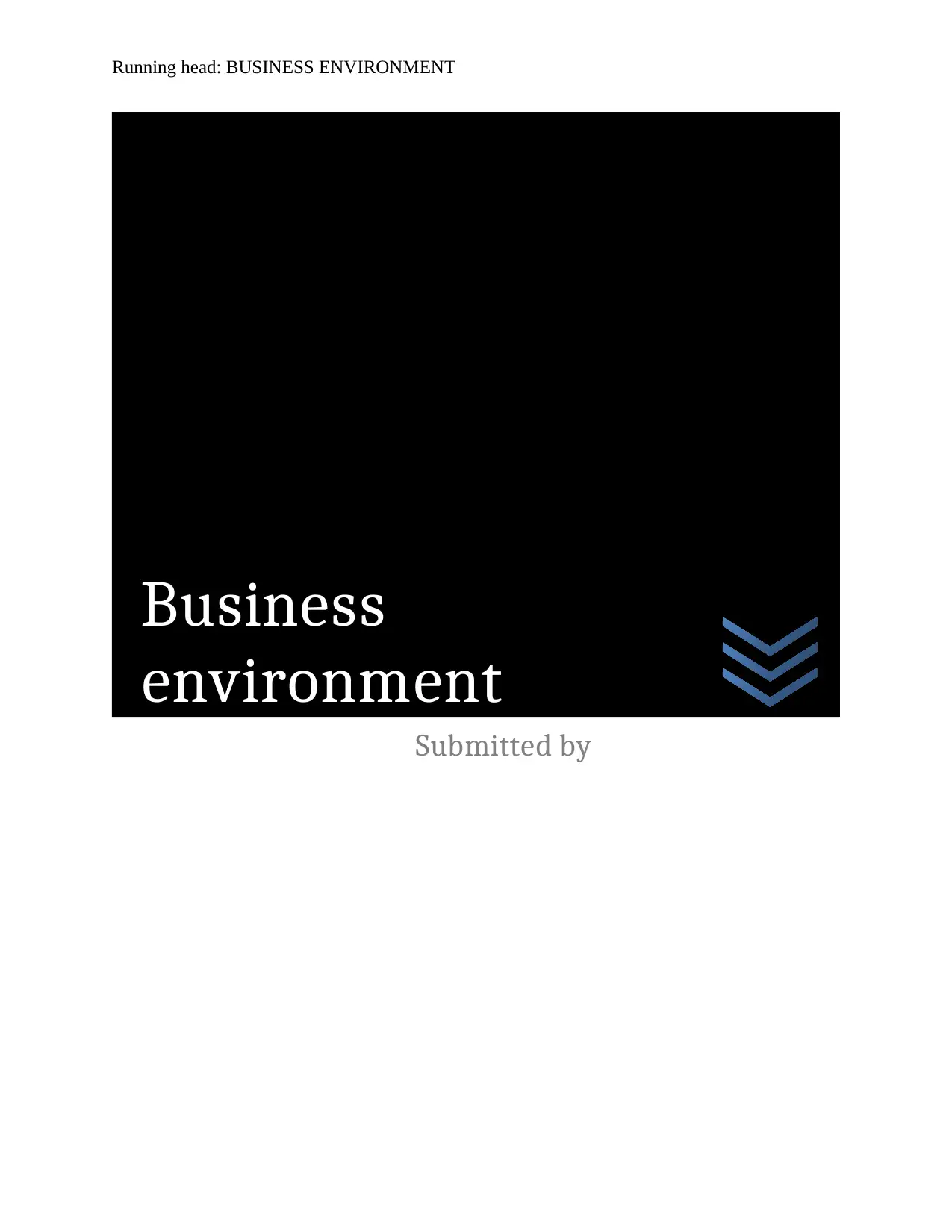
Running head: BUSINESS ENVIRONMENT
Submitted by
Business
environment
Submitted by
Business
environment
Paraphrase This Document
Need a fresh take? Get an instant paraphrase of this document with our AI Paraphraser
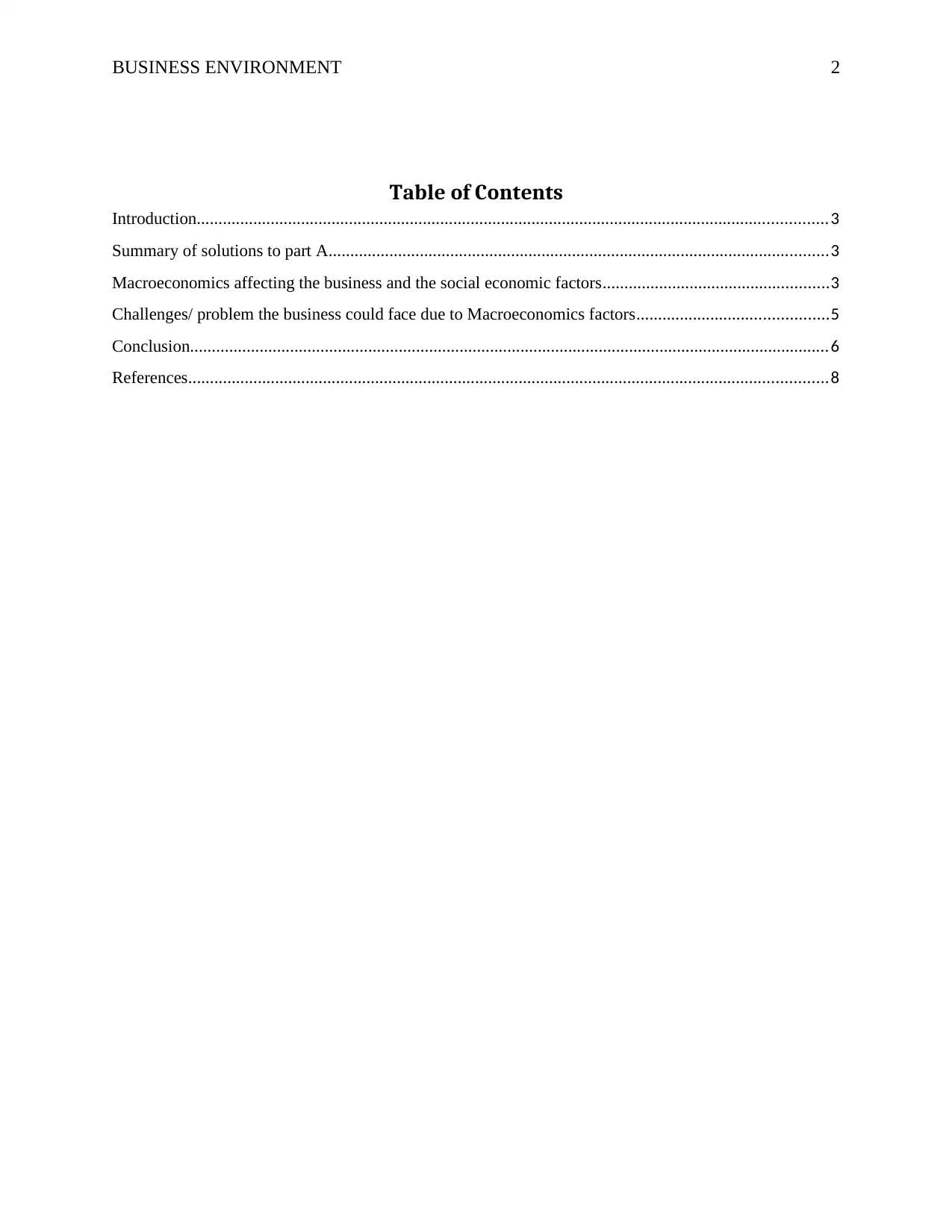
BUSINESS ENVIRONMENT 2
Table of Contents
Introduction.................................................................................................................................................3
Summary of solutions to part A...................................................................................................................3
Macroeconomics affecting the business and the social economic factors....................................................3
Challenges/ problem the business could face due to Macroeconomics factors............................................5
Conclusion...................................................................................................................................................6
References...................................................................................................................................................8
Table of Contents
Introduction.................................................................................................................................................3
Summary of solutions to part A...................................................................................................................3
Macroeconomics affecting the business and the social economic factors....................................................3
Challenges/ problem the business could face due to Macroeconomics factors............................................5
Conclusion...................................................................................................................................................6
References...................................................................................................................................................8
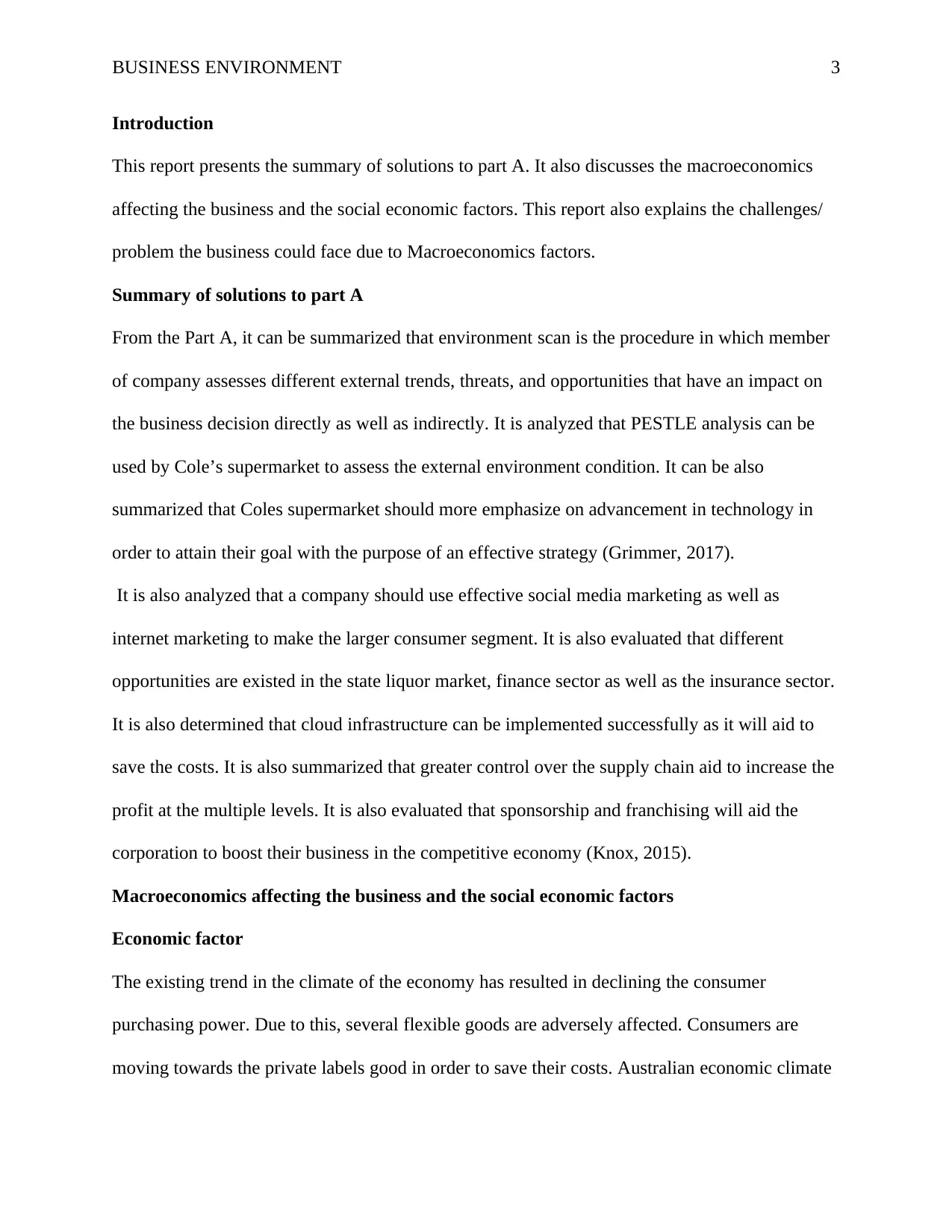
BUSINESS ENVIRONMENT 3
Introduction
This report presents the summary of solutions to part A. It also discusses the macroeconomics
affecting the business and the social economic factors. This report also explains the challenges/
problem the business could face due to Macroeconomics factors.
Summary of solutions to part A
From the Part A, it can be summarized that environment scan is the procedure in which member
of company assesses different external trends, threats, and opportunities that have an impact on
the business decision directly as well as indirectly. It is analyzed that PESTLE analysis can be
used by Cole’s supermarket to assess the external environment condition. It can be also
summarized that Coles supermarket should more emphasize on advancement in technology in
order to attain their goal with the purpose of an effective strategy (Grimmer, 2017).
It is also analyzed that a company should use effective social media marketing as well as
internet marketing to make the larger consumer segment. It is also evaluated that different
opportunities are existed in the state liquor market, finance sector as well as the insurance sector.
It is also determined that cloud infrastructure can be implemented successfully as it will aid to
save the costs. It is also summarized that greater control over the supply chain aid to increase the
profit at the multiple levels. It is also evaluated that sponsorship and franchising will aid the
corporation to boost their business in the competitive economy (Knox, 2015).
Macroeconomics affecting the business and the social economic factors
Economic factor
The existing trend in the climate of the economy has resulted in declining the consumer
purchasing power. Due to this, several flexible goods are adversely affected. Consumers are
moving towards the private labels good in order to save their costs. Australian economic climate
Introduction
This report presents the summary of solutions to part A. It also discusses the macroeconomics
affecting the business and the social economic factors. This report also explains the challenges/
problem the business could face due to Macroeconomics factors.
Summary of solutions to part A
From the Part A, it can be summarized that environment scan is the procedure in which member
of company assesses different external trends, threats, and opportunities that have an impact on
the business decision directly as well as indirectly. It is analyzed that PESTLE analysis can be
used by Cole’s supermarket to assess the external environment condition. It can be also
summarized that Coles supermarket should more emphasize on advancement in technology in
order to attain their goal with the purpose of an effective strategy (Grimmer, 2017).
It is also analyzed that a company should use effective social media marketing as well as
internet marketing to make the larger consumer segment. It is also evaluated that different
opportunities are existed in the state liquor market, finance sector as well as the insurance sector.
It is also determined that cloud infrastructure can be implemented successfully as it will aid to
save the costs. It is also summarized that greater control over the supply chain aid to increase the
profit at the multiple levels. It is also evaluated that sponsorship and franchising will aid the
corporation to boost their business in the competitive economy (Knox, 2015).
Macroeconomics affecting the business and the social economic factors
Economic factor
The existing trend in the climate of the economy has resulted in declining the consumer
purchasing power. Due to this, several flexible goods are adversely affected. Consumers are
moving towards the private labels good in order to save their costs. Australian economic climate
⊘ This is a preview!⊘
Do you want full access?
Subscribe today to unlock all pages.

Trusted by 1+ million students worldwide
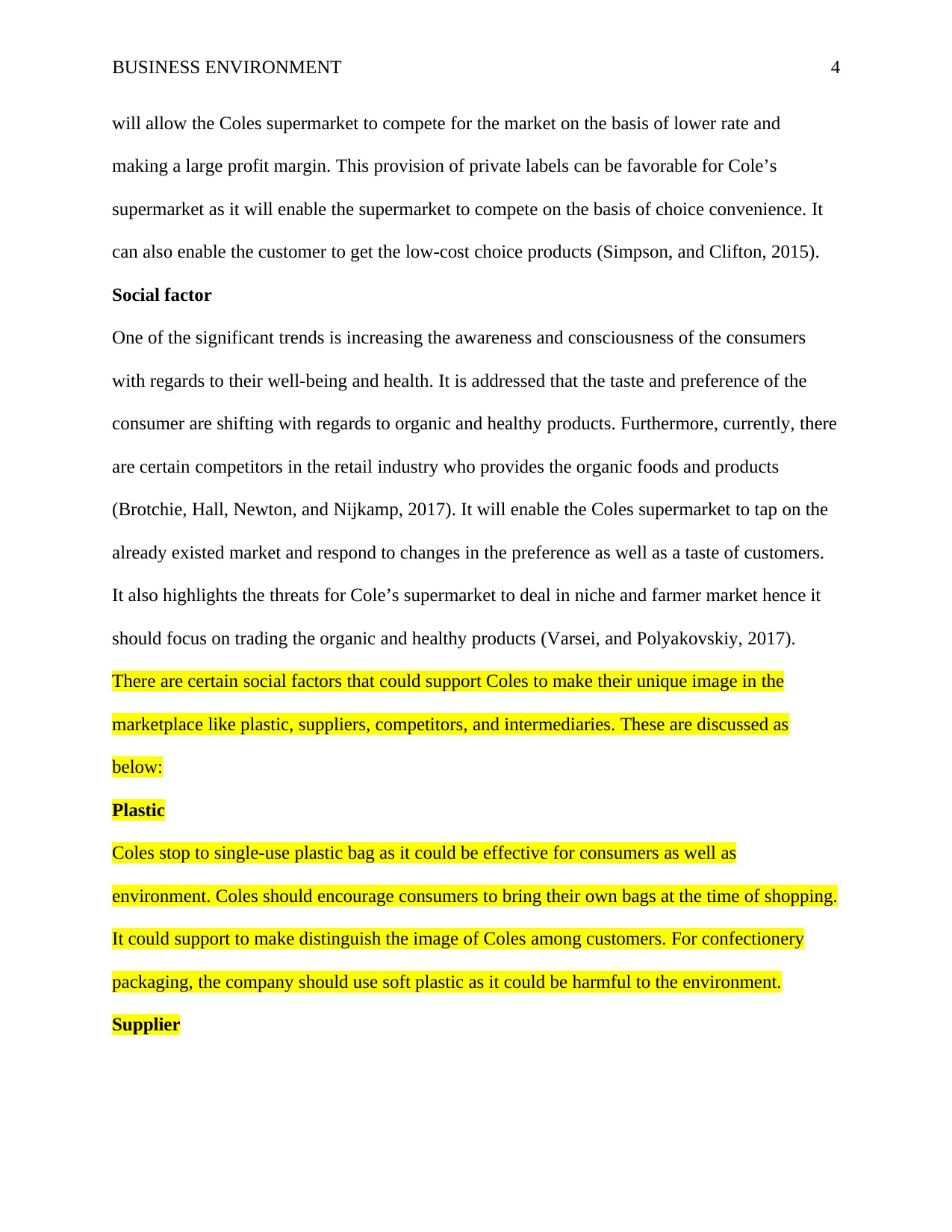
BUSINESS ENVIRONMENT 4
will allow the Coles supermarket to compete for the market on the basis of lower rate and
making a large profit margin. This provision of private labels can be favorable for Cole’s
supermarket as it will enable the supermarket to compete on the basis of choice convenience. It
can also enable the customer to get the low-cost choice products (Simpson, and Clifton, 2015).
Social factor
One of the significant trends is increasing the awareness and consciousness of the consumers
with regards to their well-being and health. It is addressed that the taste and preference of the
consumer are shifting with regards to organic and healthy products. Furthermore, currently, there
are certain competitors in the retail industry who provides the organic foods and products
(Brotchie, Hall, Newton, and Nijkamp, 2017). It will enable the Coles supermarket to tap on the
already existed market and respond to changes in the preference as well as a taste of customers.
It also highlights the threats for Cole’s supermarket to deal in niche and farmer market hence it
should focus on trading the organic and healthy products (Varsei, and Polyakovskiy, 2017).
There are certain social factors that could support Coles to make their unique image in the
marketplace like plastic, suppliers, competitors, and intermediaries. These are discussed as
below:
Plastic
Coles stop to single-use plastic bag as it could be effective for consumers as well as
environment. Coles should encourage consumers to bring their own bags at the time of shopping.
It could support to make distinguish the image of Coles among customers. For confectionery
packaging, the company should use soft plastic as it could be harmful to the environment.
Supplier
will allow the Coles supermarket to compete for the market on the basis of lower rate and
making a large profit margin. This provision of private labels can be favorable for Cole’s
supermarket as it will enable the supermarket to compete on the basis of choice convenience. It
can also enable the customer to get the low-cost choice products (Simpson, and Clifton, 2015).
Social factor
One of the significant trends is increasing the awareness and consciousness of the consumers
with regards to their well-being and health. It is addressed that the taste and preference of the
consumer are shifting with regards to organic and healthy products. Furthermore, currently, there
are certain competitors in the retail industry who provides the organic foods and products
(Brotchie, Hall, Newton, and Nijkamp, 2017). It will enable the Coles supermarket to tap on the
already existed market and respond to changes in the preference as well as a taste of customers.
It also highlights the threats for Cole’s supermarket to deal in niche and farmer market hence it
should focus on trading the organic and healthy products (Varsei, and Polyakovskiy, 2017).
There are certain social factors that could support Coles to make their unique image in the
marketplace like plastic, suppliers, competitors, and intermediaries. These are discussed as
below:
Plastic
Coles stop to single-use plastic bag as it could be effective for consumers as well as
environment. Coles should encourage consumers to bring their own bags at the time of shopping.
It could support to make distinguish the image of Coles among customers. For confectionery
packaging, the company should use soft plastic as it could be harmful to the environment.
Supplier
Paraphrase This Document
Need a fresh take? Get an instant paraphrase of this document with our AI Paraphraser
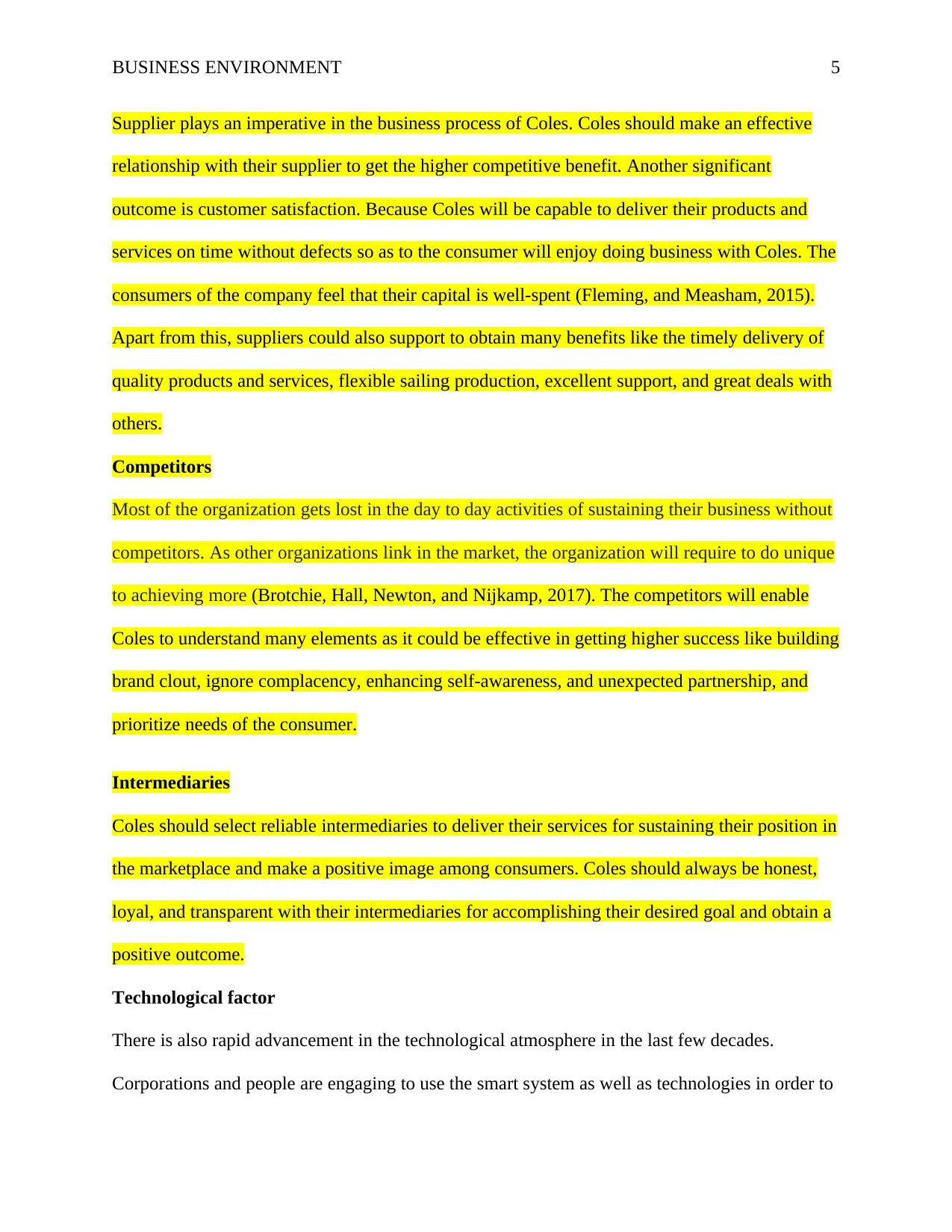
BUSINESS ENVIRONMENT 5
Supplier plays an imperative in the business process of Coles. Coles should make an effective
relationship with their supplier to get the higher competitive benefit. Another significant
outcome is customer satisfaction. Because Coles will be capable to deliver their products and
services on time without defects so as to the consumer will enjoy doing business with Coles. The
consumers of the company feel that their capital is well-spent (Fleming, and Measham, 2015).
Apart from this, suppliers could also support to obtain many benefits like the timely delivery of
quality products and services, flexible sailing production, excellent support, and great deals with
others.
Competitors
Most of the organization gets lost in the day to day activities of sustaining their business without
competitors. As other organizations link in the market, the organization will require to do unique
to achieving more (Brotchie, Hall, Newton, and Nijkamp, 2017). The competitors will enable
Coles to understand many elements as it could be effective in getting higher success like building
brand clout, ignore complacency, enhancing self-awareness, and unexpected partnership, and
prioritize needs of the consumer.
Intermediaries
Coles should select reliable intermediaries to deliver their services for sustaining their position in
the marketplace and make a positive image among consumers. Coles should always be honest,
loyal, and transparent with their intermediaries for accomplishing their desired goal and obtain a
positive outcome.
Technological factor
There is also rapid advancement in the technological atmosphere in the last few decades.
Corporations and people are engaging to use the smart system as well as technologies in order to
Supplier plays an imperative in the business process of Coles. Coles should make an effective
relationship with their supplier to get the higher competitive benefit. Another significant
outcome is customer satisfaction. Because Coles will be capable to deliver their products and
services on time without defects so as to the consumer will enjoy doing business with Coles. The
consumers of the company feel that their capital is well-spent (Fleming, and Measham, 2015).
Apart from this, suppliers could also support to obtain many benefits like the timely delivery of
quality products and services, flexible sailing production, excellent support, and great deals with
others.
Competitors
Most of the organization gets lost in the day to day activities of sustaining their business without
competitors. As other organizations link in the market, the organization will require to do unique
to achieving more (Brotchie, Hall, Newton, and Nijkamp, 2017). The competitors will enable
Coles to understand many elements as it could be effective in getting higher success like building
brand clout, ignore complacency, enhancing self-awareness, and unexpected partnership, and
prioritize needs of the consumer.
Intermediaries
Coles should select reliable intermediaries to deliver their services for sustaining their position in
the marketplace and make a positive image among consumers. Coles should always be honest,
loyal, and transparent with their intermediaries for accomplishing their desired goal and obtain a
positive outcome.
Technological factor
There is also rapid advancement in the technological atmosphere in the last few decades.
Corporations and people are engaging to use the smart system as well as technologies in order to
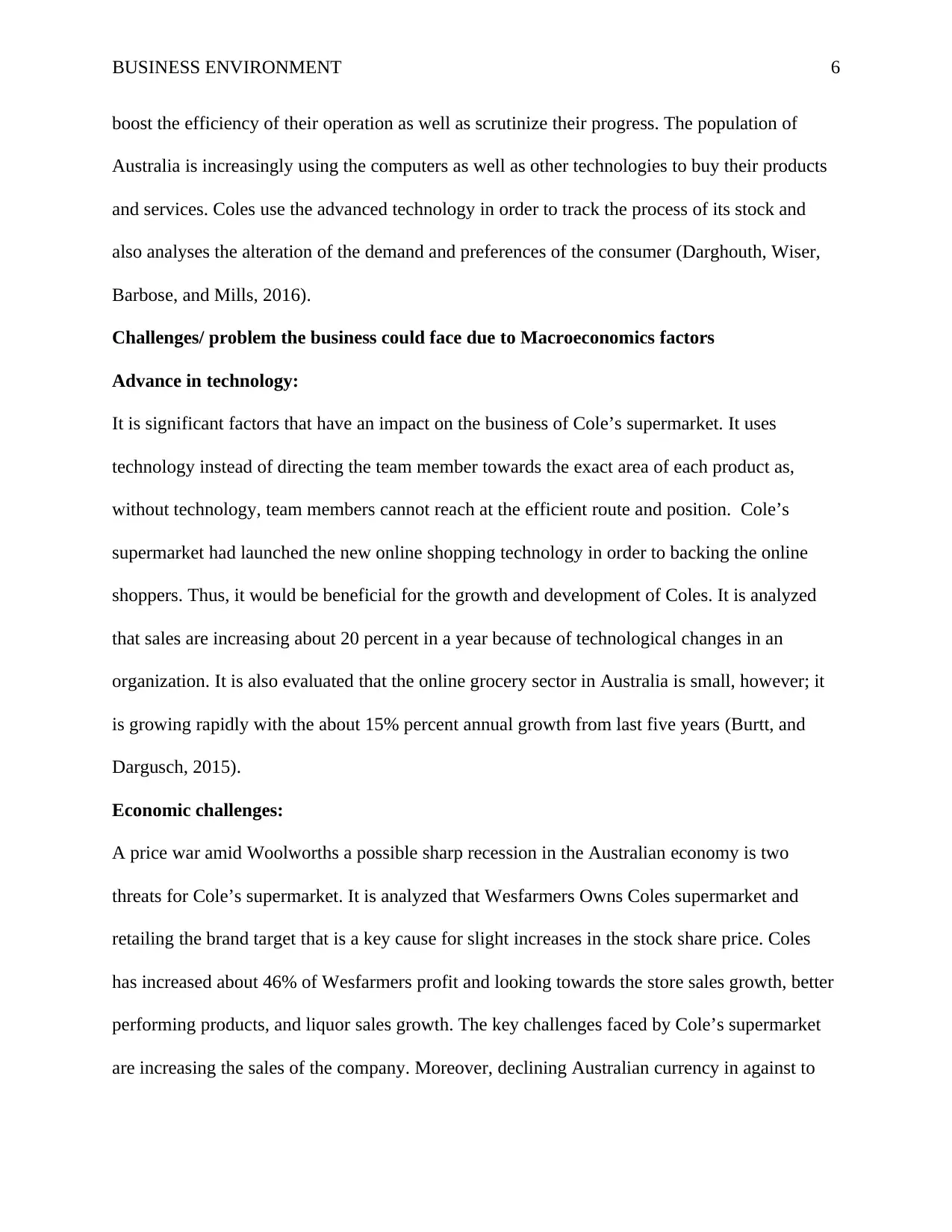
BUSINESS ENVIRONMENT 6
boost the efficiency of their operation as well as scrutinize their progress. The population of
Australia is increasingly using the computers as well as other technologies to buy their products
and services. Coles use the advanced technology in order to track the process of its stock and
also analyses the alteration of the demand and preferences of the consumer (Darghouth, Wiser,
Barbose, and Mills, 2016).
Challenges/ problem the business could face due to Macroeconomics factors
Advance in technology:
It is significant factors that have an impact on the business of Cole’s supermarket. It uses
technology instead of directing the team member towards the exact area of each product as,
without technology, team members cannot reach at the efficient route and position. Cole’s
supermarket had launched the new online shopping technology in order to backing the online
shoppers. Thus, it would be beneficial for the growth and development of Coles. It is analyzed
that sales are increasing about 20 percent in a year because of technological changes in an
organization. It is also evaluated that the online grocery sector in Australia is small, however; it
is growing rapidly with the about 15% percent annual growth from last five years (Burtt, and
Dargusch, 2015).
Economic challenges:
A price war amid Woolworths a possible sharp recession in the Australian economy is two
threats for Cole’s supermarket. It is analyzed that Wesfarmers Owns Coles supermarket and
retailing the brand target that is a key cause for slight increases in the stock share price. Coles
has increased about 46% of Wesfarmers profit and looking towards the store sales growth, better
performing products, and liquor sales growth. The key challenges faced by Cole’s supermarket
are increasing the sales of the company. Moreover, declining Australian currency in against to
boost the efficiency of their operation as well as scrutinize their progress. The population of
Australia is increasingly using the computers as well as other technologies to buy their products
and services. Coles use the advanced technology in order to track the process of its stock and
also analyses the alteration of the demand and preferences of the consumer (Darghouth, Wiser,
Barbose, and Mills, 2016).
Challenges/ problem the business could face due to Macroeconomics factors
Advance in technology:
It is significant factors that have an impact on the business of Cole’s supermarket. It uses
technology instead of directing the team member towards the exact area of each product as,
without technology, team members cannot reach at the efficient route and position. Cole’s
supermarket had launched the new online shopping technology in order to backing the online
shoppers. Thus, it would be beneficial for the growth and development of Coles. It is analyzed
that sales are increasing about 20 percent in a year because of technological changes in an
organization. It is also evaluated that the online grocery sector in Australia is small, however; it
is growing rapidly with the about 15% percent annual growth from last five years (Burtt, and
Dargusch, 2015).
Economic challenges:
A price war amid Woolworths a possible sharp recession in the Australian economy is two
threats for Cole’s supermarket. It is analyzed that Wesfarmers Owns Coles supermarket and
retailing the brand target that is a key cause for slight increases in the stock share price. Coles
has increased about 46% of Wesfarmers profit and looking towards the store sales growth, better
performing products, and liquor sales growth. The key challenges faced by Cole’s supermarket
are increasing the sales of the company. Moreover, declining Australian currency in against to
⊘ This is a preview!⊘
Do you want full access?
Subscribe today to unlock all pages.

Trusted by 1+ million students worldwide
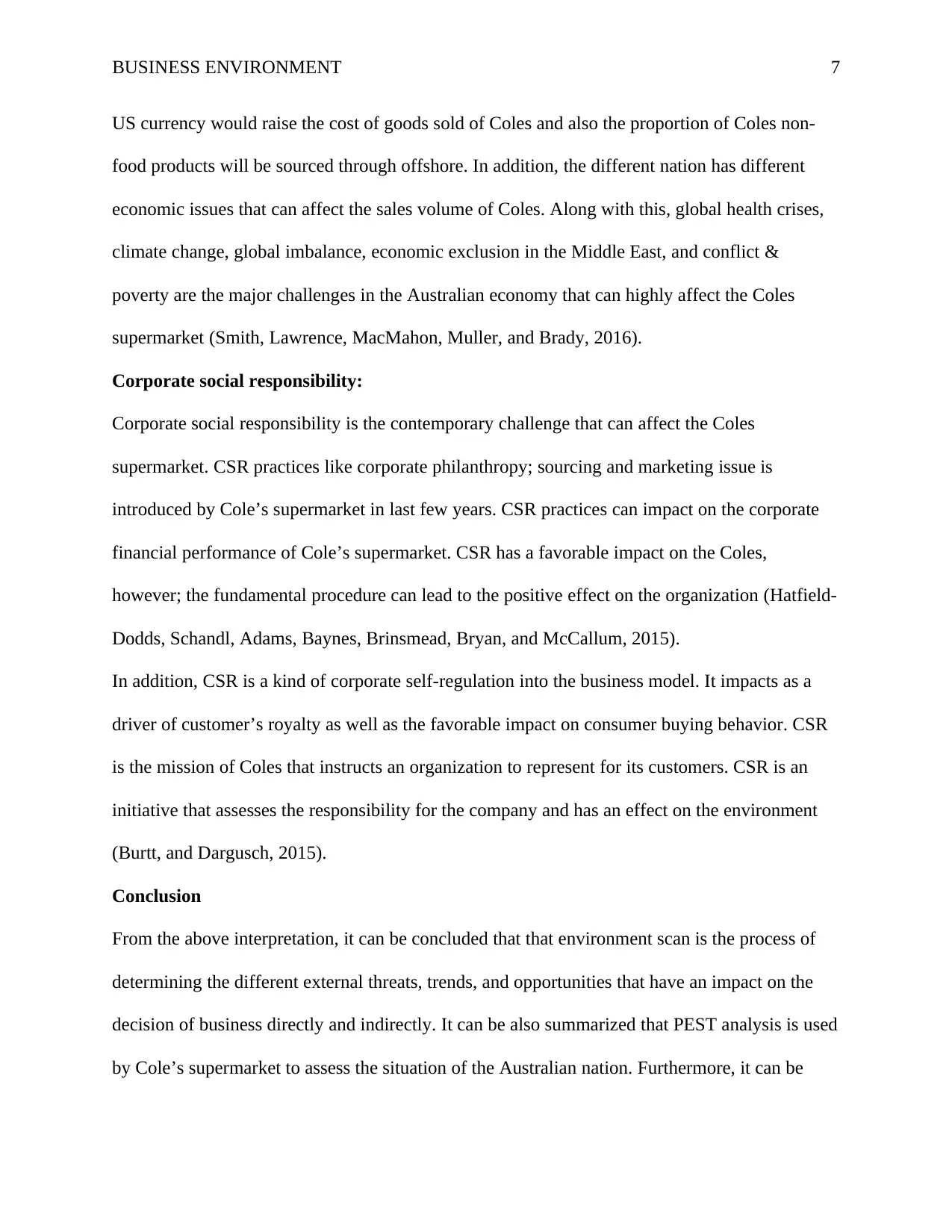
BUSINESS ENVIRONMENT 7
US currency would raise the cost of goods sold of Coles and also the proportion of Coles non-
food products will be sourced through offshore. In addition, the different nation has different
economic issues that can affect the sales volume of Coles. Along with this, global health crises,
climate change, global imbalance, economic exclusion in the Middle East, and conflict &
poverty are the major challenges in the Australian economy that can highly affect the Coles
supermarket (Smith, Lawrence, MacMahon, Muller, and Brady, 2016).
Corporate social responsibility:
Corporate social responsibility is the contemporary challenge that can affect the Coles
supermarket. CSR practices like corporate philanthropy; sourcing and marketing issue is
introduced by Cole’s supermarket in last few years. CSR practices can impact on the corporate
financial performance of Cole’s supermarket. CSR has a favorable impact on the Coles,
however; the fundamental procedure can lead to the positive effect on the organization (Hatfield-
Dodds, Schandl, Adams, Baynes, Brinsmead, Bryan, and McCallum, 2015).
In addition, CSR is a kind of corporate self-regulation into the business model. It impacts as a
driver of customer’s royalty as well as the favorable impact on consumer buying behavior. CSR
is the mission of Coles that instructs an organization to represent for its customers. CSR is an
initiative that assesses the responsibility for the company and has an effect on the environment
(Burtt, and Dargusch, 2015).
Conclusion
From the above interpretation, it can be concluded that that environment scan is the process of
determining the different external threats, trends, and opportunities that have an impact on the
decision of business directly and indirectly. It can be also summarized that PEST analysis is used
by Cole’s supermarket to assess the situation of the Australian nation. Furthermore, it can be
US currency would raise the cost of goods sold of Coles and also the proportion of Coles non-
food products will be sourced through offshore. In addition, the different nation has different
economic issues that can affect the sales volume of Coles. Along with this, global health crises,
climate change, global imbalance, economic exclusion in the Middle East, and conflict &
poverty are the major challenges in the Australian economy that can highly affect the Coles
supermarket (Smith, Lawrence, MacMahon, Muller, and Brady, 2016).
Corporate social responsibility:
Corporate social responsibility is the contemporary challenge that can affect the Coles
supermarket. CSR practices like corporate philanthropy; sourcing and marketing issue is
introduced by Cole’s supermarket in last few years. CSR practices can impact on the corporate
financial performance of Cole’s supermarket. CSR has a favorable impact on the Coles,
however; the fundamental procedure can lead to the positive effect on the organization (Hatfield-
Dodds, Schandl, Adams, Baynes, Brinsmead, Bryan, and McCallum, 2015).
In addition, CSR is a kind of corporate self-regulation into the business model. It impacts as a
driver of customer’s royalty as well as the favorable impact on consumer buying behavior. CSR
is the mission of Coles that instructs an organization to represent for its customers. CSR is an
initiative that assesses the responsibility for the company and has an effect on the environment
(Burtt, and Dargusch, 2015).
Conclusion
From the above interpretation, it can be concluded that that environment scan is the process of
determining the different external threats, trends, and opportunities that have an impact on the
decision of business directly and indirectly. It can be also summarized that PEST analysis is used
by Cole’s supermarket to assess the situation of the Australian nation. Furthermore, it can be
Paraphrase This Document
Need a fresh take? Get an instant paraphrase of this document with our AI Paraphraser
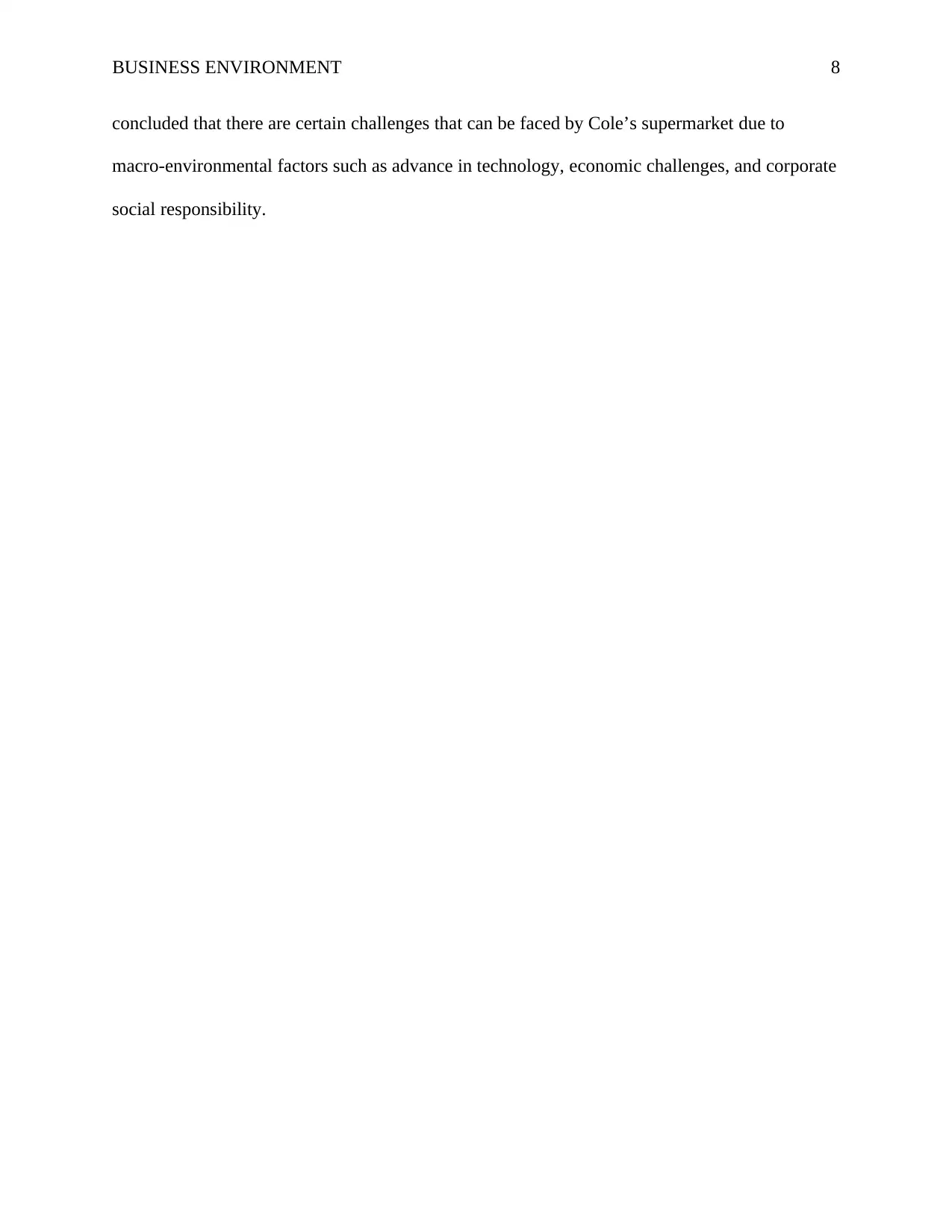
BUSINESS ENVIRONMENT 8
concluded that there are certain challenges that can be faced by Cole’s supermarket due to
macro-environmental factors such as advance in technology, economic challenges, and corporate
social responsibility.
concluded that there are certain challenges that can be faced by Cole’s supermarket due to
macro-environmental factors such as advance in technology, economic challenges, and corporate
social responsibility.
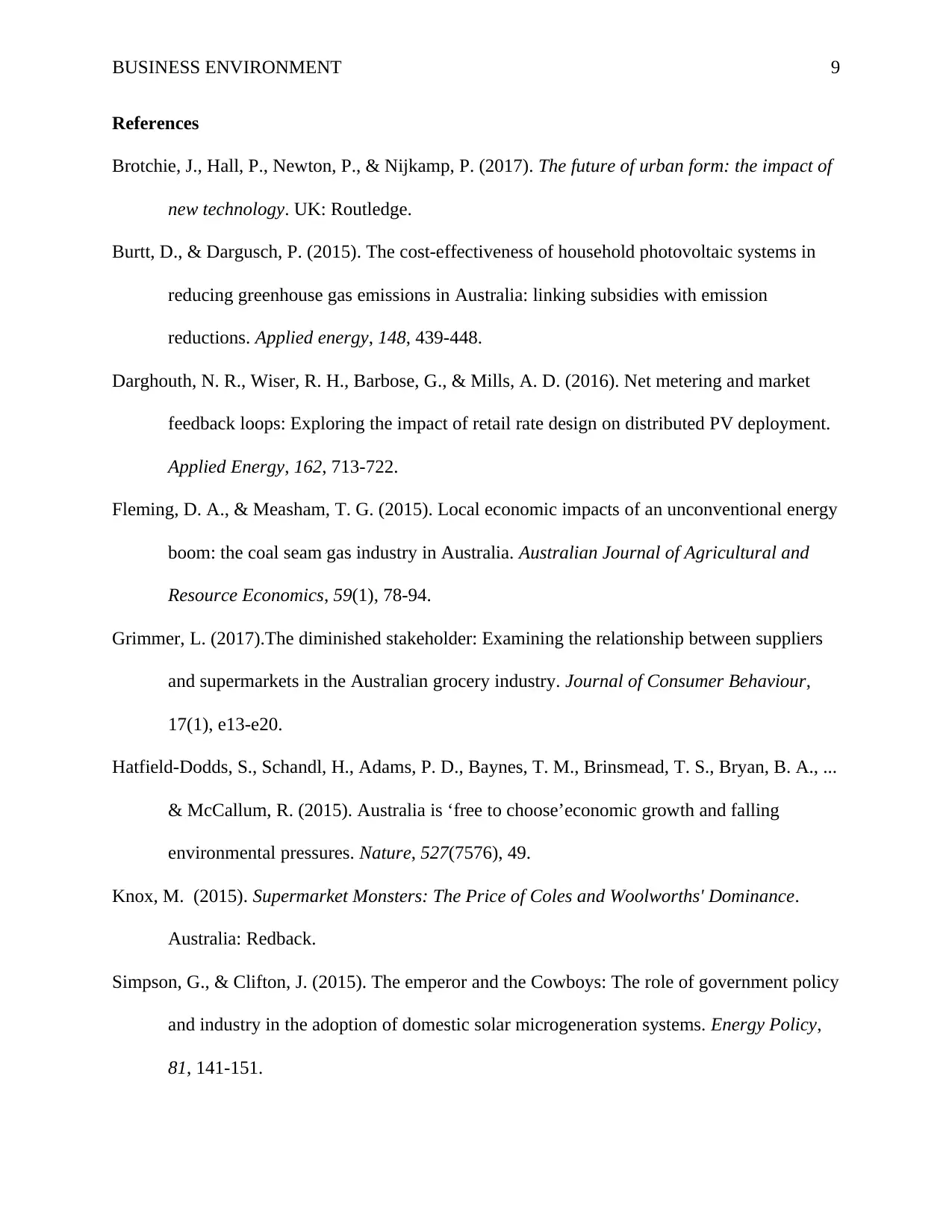
BUSINESS ENVIRONMENT 9
References
Brotchie, J., Hall, P., Newton, P., & Nijkamp, P. (2017). The future of urban form: the impact of
new technology. UK: Routledge.
Burtt, D., & Dargusch, P. (2015). The cost-effectiveness of household photovoltaic systems in
reducing greenhouse gas emissions in Australia: linking subsidies with emission
reductions. Applied energy, 148, 439-448.
Darghouth, N. R., Wiser, R. H., Barbose, G., & Mills, A. D. (2016). Net metering and market
feedback loops: Exploring the impact of retail rate design on distributed PV deployment.
Applied Energy, 162, 713-722.
Fleming, D. A., & Measham, T. G. (2015). Local economic impacts of an unconventional energy
boom: the coal seam gas industry in Australia. Australian Journal of Agricultural and
Resource Economics, 59(1), 78-94.
Grimmer, L. (2017).The diminished stakeholder: Examining the relationship between suppliers
and supermarkets in the Australian grocery industry. Journal of Consumer Behaviour,
17(1), e13-e20.
Hatfield-Dodds, S., Schandl, H., Adams, P. D., Baynes, T. M., Brinsmead, T. S., Bryan, B. A., ...
& McCallum, R. (2015). Australia is ‘free to choose’economic growth and falling
environmental pressures. Nature, 527(7576), 49.
Knox, M. (2015). Supermarket Monsters: The Price of Coles and Woolworths' Dominance.
Australia: Redback.
Simpson, G., & Clifton, J. (2015). The emperor and the Cowboys: The role of government policy
and industry in the adoption of domestic solar microgeneration systems. Energy Policy,
81, 141-151.
References
Brotchie, J., Hall, P., Newton, P., & Nijkamp, P. (2017). The future of urban form: the impact of
new technology. UK: Routledge.
Burtt, D., & Dargusch, P. (2015). The cost-effectiveness of household photovoltaic systems in
reducing greenhouse gas emissions in Australia: linking subsidies with emission
reductions. Applied energy, 148, 439-448.
Darghouth, N. R., Wiser, R. H., Barbose, G., & Mills, A. D. (2016). Net metering and market
feedback loops: Exploring the impact of retail rate design on distributed PV deployment.
Applied Energy, 162, 713-722.
Fleming, D. A., & Measham, T. G. (2015). Local economic impacts of an unconventional energy
boom: the coal seam gas industry in Australia. Australian Journal of Agricultural and
Resource Economics, 59(1), 78-94.
Grimmer, L. (2017).The diminished stakeholder: Examining the relationship between suppliers
and supermarkets in the Australian grocery industry. Journal of Consumer Behaviour,
17(1), e13-e20.
Hatfield-Dodds, S., Schandl, H., Adams, P. D., Baynes, T. M., Brinsmead, T. S., Bryan, B. A., ...
& McCallum, R. (2015). Australia is ‘free to choose’economic growth and falling
environmental pressures. Nature, 527(7576), 49.
Knox, M. (2015). Supermarket Monsters: The Price of Coles and Woolworths' Dominance.
Australia: Redback.
Simpson, G., & Clifton, J. (2015). The emperor and the Cowboys: The role of government policy
and industry in the adoption of domestic solar microgeneration systems. Energy Policy,
81, 141-151.
⊘ This is a preview!⊘
Do you want full access?
Subscribe today to unlock all pages.

Trusted by 1+ million students worldwide
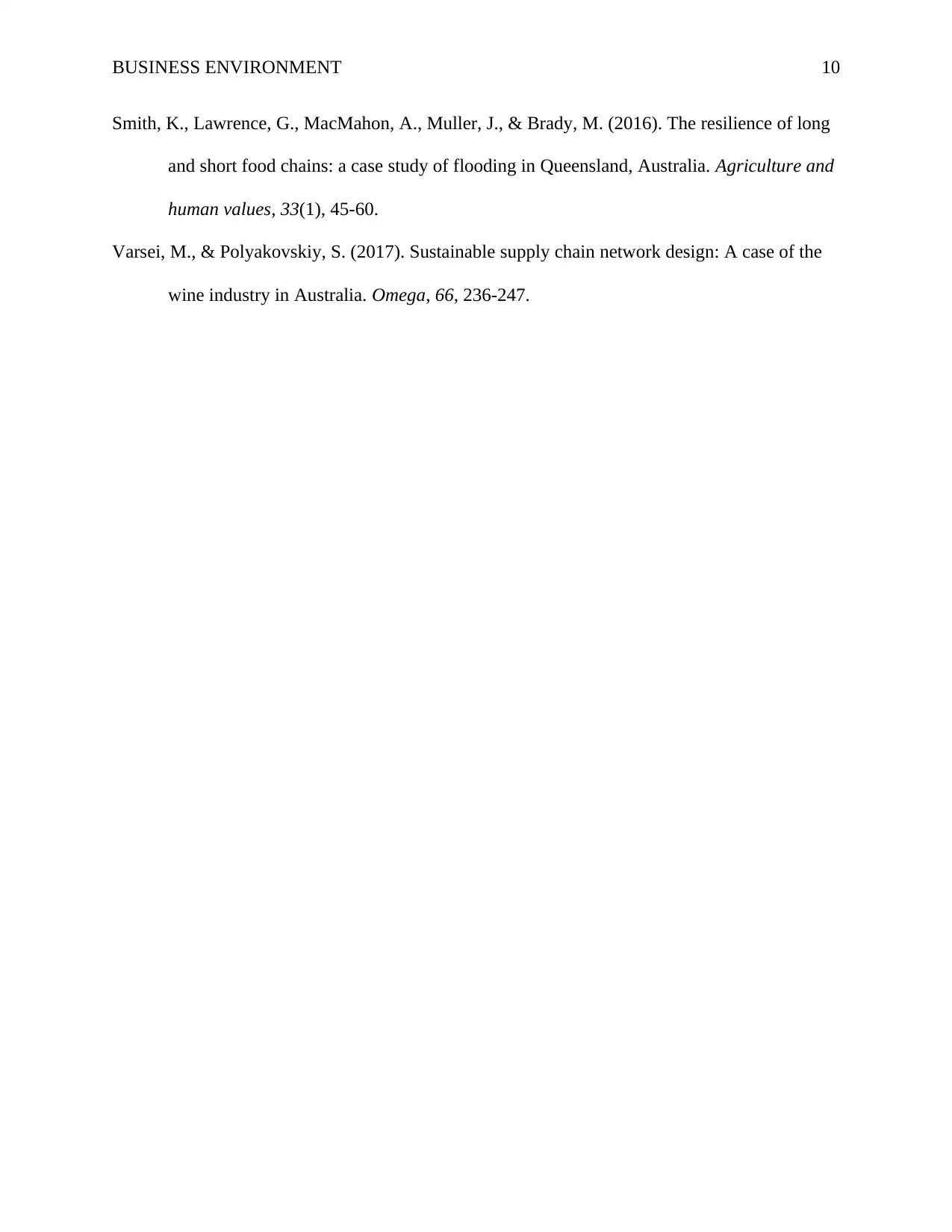
BUSINESS ENVIRONMENT 10
Smith, K., Lawrence, G., MacMahon, A., Muller, J., & Brady, M. (2016). The resilience of long
and short food chains: a case study of flooding in Queensland, Australia. Agriculture and
human values, 33(1), 45-60.
Varsei, M., & Polyakovskiy, S. (2017). Sustainable supply chain network design: A case of the
wine industry in Australia. Omega, 66, 236-247.
Smith, K., Lawrence, G., MacMahon, A., Muller, J., & Brady, M. (2016). The resilience of long
and short food chains: a case study of flooding in Queensland, Australia. Agriculture and
human values, 33(1), 45-60.
Varsei, M., & Polyakovskiy, S. (2017). Sustainable supply chain network design: A case of the
wine industry in Australia. Omega, 66, 236-247.
1 out of 10
Related Documents
Your All-in-One AI-Powered Toolkit for Academic Success.
+13062052269
info@desklib.com
Available 24*7 on WhatsApp / Email
![[object Object]](/_next/static/media/star-bottom.7253800d.svg)
Unlock your academic potential
Copyright © 2020–2025 A2Z Services. All Rights Reserved. Developed and managed by ZUCOL.





